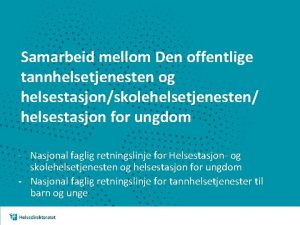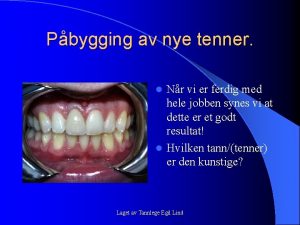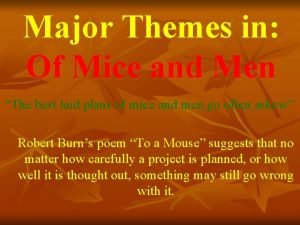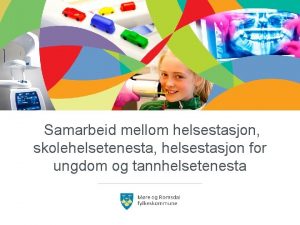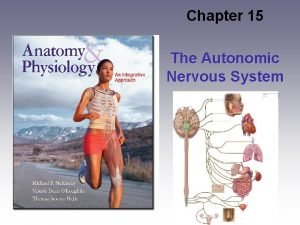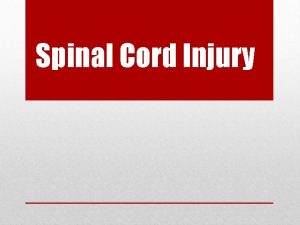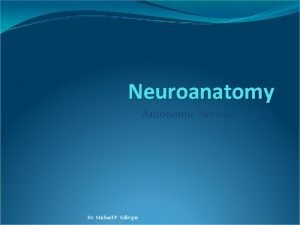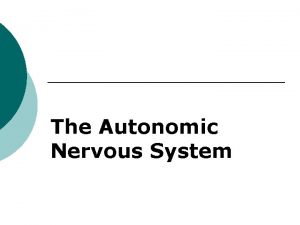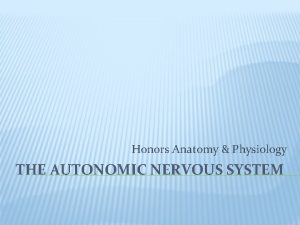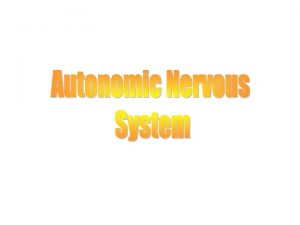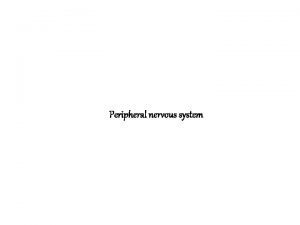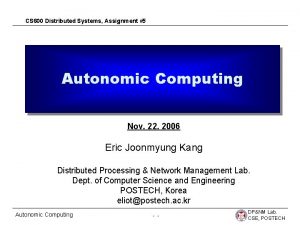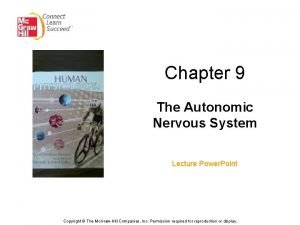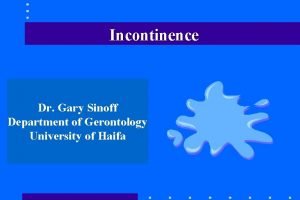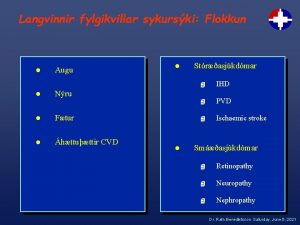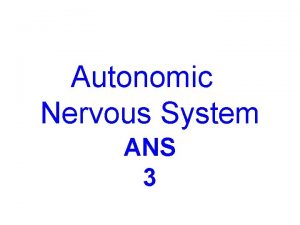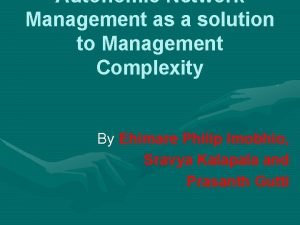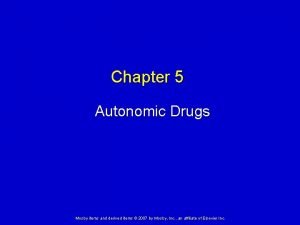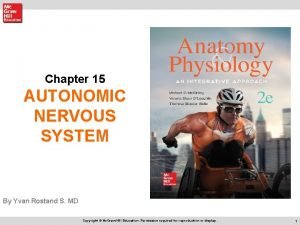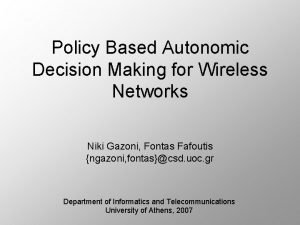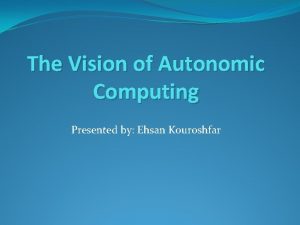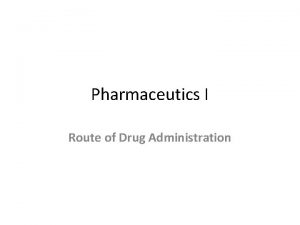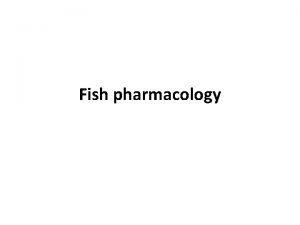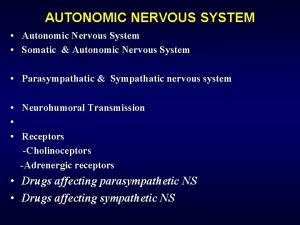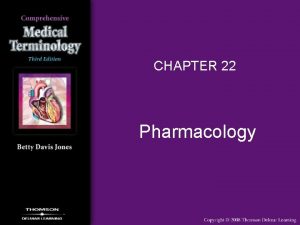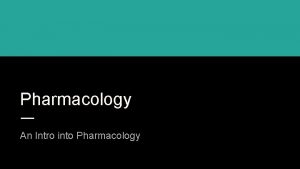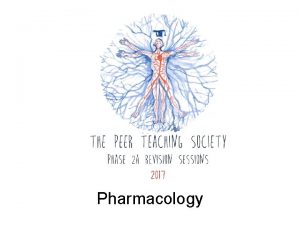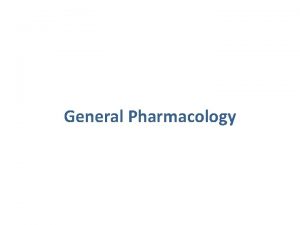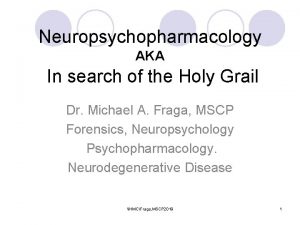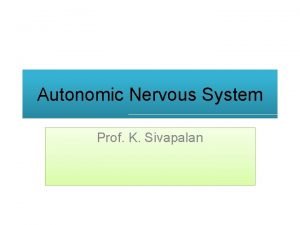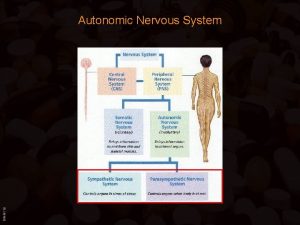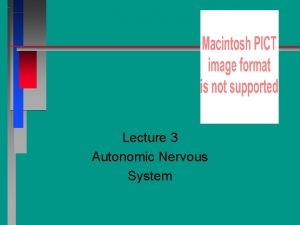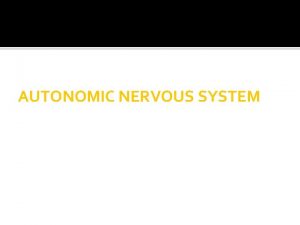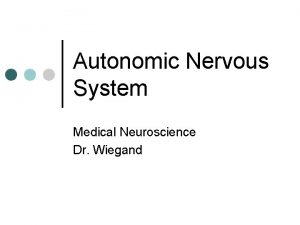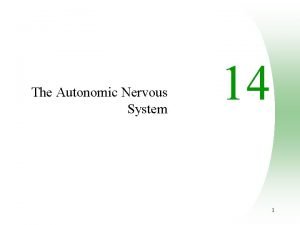QA Autonomic Pharmacology Neuropsychopharmacology Thomas E Tenner Jr









![Drugs (topical) used to treat glaucoma • Alpha 2 adrenergic agonists** • Apraclonidine [Lopidine] Drugs (topical) used to treat glaucoma • Alpha 2 adrenergic agonists** • Apraclonidine [Lopidine]](https://slidetodoc.com/presentation_image_h2/4d012c3942a174b93e7664a1deecedd8/image-10.jpg)

























- Slides: 35

Q&A Autonomic Pharmacology: Neuropsychopharmacology Thomas E. Tenner, Jr. , Ph. D. Dept. of Medical Education Dept. Pharmacology & Neuroscience tom. tenner@ttuhsc. edu 743 -7169 October 22, 2018

Session Plan: • Cholinergic Agonists • Review of Glaucoma Medications • Cholinergic Antagonists • Adrenergic Antagonists

Cholinergic Agonists Muscarinic/Nicotinic Direct/ Indirect

A 15 -year-old female suspected to have asthma undergoes a test to establish a ‘bronchial hyperactivity diagnosis’. Which of the following autonomic receptors will be challenged? A. B. C. D. E. F. G. H. Alpha - 1 adrenergic Alpha - 2 adrenergic Beta - 1 adrenergic Beta - 2 adrenergic Dopamine - 1 adrenergic Dopamine - 2 adrenergic Muscarinic Nicotinic

“DUMBBELSS” - Muscarinic effects • • • D - Diarrhea U - Urination M - Miosis B - Bradycardia B - Bronchoconstriction E - Emesis L - Lacrimation S - Salivation S - Sweating

“SLUDWARMF” - Muscarinic and Nicotinic • • • Sweating Lacrimation Urination Diarrhea Wheezing Accommodation Rhinorrhea Miosis Skeletal Muscle Fasciculations Muscarinic Nicotinic 6

An Alzheimer's patient receives a “cholinergic agonist” which results in all of the adverse effects listed below. Which specific adverse effect proves that the patient is receiving an ‘indirect-acting’ rather than ‘direct-acting’ muscarinic agonist? A. B. C. D. Bradycardia Dyspepsia Rhinorrhea Skeletal muscle fasciculations E. Sweating

All of the following cholinergic drugs could cause muscle fasciculations, respiratory arrest, and malignant hyperthermia EXCEPT A. B. C. D. E. F. Bethanechol Echothiophate Edrophonium Pyridostigmine Rivastigmine Succinylcholine

This drug, now rarely used to treat glaucoma and lower intraocular pressure (IOP), can result in pupillary miosis, lacrimation, salivation, and rhinorrhea when applied topically to the eye. To what class of drugs does it belong? A. B. C. D. E. F. Alpha-2 Adrenoceptor agonist Beta- blocker Carbonic Anhydrase inhibitor Muscarinic receptor agonist Nicotinic receptor agonist Prostaglandin analog
![Drugs topical used to treat glaucoma Alpha 2 adrenergic agonists Apraclonidine Lopidine Drugs (topical) used to treat glaucoma • Alpha 2 adrenergic agonists** • Apraclonidine [Lopidine]](https://slidetodoc.com/presentation_image_h2/4d012c3942a174b93e7664a1deecedd8/image-10.jpg)
Drugs (topical) used to treat glaucoma • Alpha 2 adrenergic agonists** • Apraclonidine [Lopidine] • Brimonidine [Alphagan P] • Beta blockers *: • Carteolol • Timolol [Timoptic] • Cholinergic agonists***: • Direct - Pilocarpine • Indirect (Anticholinesterase agents) Echothiophate [Phospholine] • Carbonic anhydrase inhibitors **: • Brinzolamide [Azopt] • Dorzolamide [ Trusopt ] • Prostaglandin analogs*: • Bimatoprost [Lumigan] • Latanoprost [Xalatan] 10

Autonomic control in the eye:

Patient receives a cholinergic agonist that results in tachycardia and hypertension. Which drug was administered? A. B. C. D. E. F. Atropine Bethanechol Echothiophate Nicotine Pyridostigmine Succinylcholine

Cholinergic Antagonists: Muscarinic/Nicotinic

Which of the following could precipitate an acute attack of narrow angle glaucoma? A. Atropine B. Echothiophate (Phospholine Iodide) C. Physostigmine D. Pilocarpine (Isopto, Carpine, Pilopine) E. Timolol (Timoptic) 14

Patient taking the antidepressant, Amitriptyline, for relief of neuropathic pain, complains of blurred vision, xerostomia, tachycardia, hyperthermia, constipation, and urinary retention. These adverse effects of amitriptyline result from A. blockade of muscarinic receptors. B. blockade of alpha-1 adrenoceptors. C. blockade of Beta-1 adrenoceptors. D. blockade of Dopamine-2 adrenoceptors. E. inhibition of Norepinephrine and Serotonin reuptake.

In severe neuromuscular blockade requiring respiratory ventilation, neostigmine would be most effective as an antidote when the toxicity was the result of A. B. C. D. edrophonium (Tensilon). echothiophate. pancuronium (Pavulon). pyridostigmine (Mestinon) E. succinylcholine (Anectine). 16

This drug, FDA approved for prevention of chronic migraine, can produce a “flaccid” paralysis of skeletal muscle fibers by blocking acetylcholine release from cholinergic nerve terminals. A. Black widow spider venom B. Echothiophate (Phospholine Iodide) C. Onabotulinumtoxin. A (Botox) D. Pyridostigmine (Mestinon) E. Succinylcholine (Anectine) 17

Adrenergic Agonists: Alpha/Beta Direct/ Indirect/Mixed

Oral phenylephrine has been shown to be no better than placebo in the treatment of rhinorrhea associated with allergies and the common cold. Oral pseudoephedrine and intranasal oxymetazoline were both found to be superior to phenylephrine. Which adrenoceptor is responsible for the decongestant action? A. B. C. D. E. Alpha-1 adrenoceptors Alpha-2 adrenoceptors Beta-1 adrenoceptors Beta-2 adrenoceptors Beta-3 adrenoceptors

When pupillary dilation but not cycloplegia is desired, a good choice would be: A. a muscarinic antagonist. B. a beta-2 agonist. C. a nonselective betablocker. D. a muscarinic agonist. E. an alpha agonist 20

Which of the following could precipitate an acute attack of narrow angle glaucoma? A. Epinephrine B. Isoproterenol C. Pilocarpine (Isopto, Carpine, Pilopine) D. Prazosin E. Timolol (Timoptic) 21

A patient presents with Horner’s Syndrome. You observe that the right eye pupil diameter is smaller (miosis) than that seen in the left eye. However, when topical phenylephrine is added in both eyes, the mydriasis observed is greatest in the right eye. You could argue that these observations result from A. Parasympathetic predominance in the left eye B. Loss of Parasympathetic innervation in the right eye. C. Loss of sympathetic innervation in the right eye. D. Loss of sympathetic innervation in the left eye. E. Sympathetic predominance in the right eye.

A patient presents with Horner’s Syndrome. You observe that the right eye pupil diameter is smaller (miosis) than that seen in the left eye. Which of the following drugs would dilate the pupil (mydriasis) in left eye but NOT in the right eye? A. B. C. D. E. Amphetamine Isoproterenol Phenylephrine Prazosin Tropicamide

A patient is brought into the ER having overdosed with amphetamine. A likely cardiovascular response you could expect would be ? A. Bradycardia B. Decreased splanchnic arterial pressure C. Diminished preload D. Increased total peripheral resistance E. Negative Inotropic response in cardiac ventricles 24

While the exact mechanism of action is unknown, this drug, used in the treatment of Attention Deficit Hyperactivity Disorder (ADHD), is known as an alpha-2 agonist. A. B. C. D. E. F. Apraclonidine (Lopidine) Brimonidine (Alphagan-P) Clonidine (Catapres) Oxymetazoline (Afrin) Phenylephrine (Sudafed) Pseudoephedrine (Sudafed, Zephrex-D)

Hospitalized patient experiences anaphylactic reaction to medication and receives epinephrine. As anaphylaxis resolves you noticed fine skeletal muscle tremors. These result from Epinephrine stimulation of A. B. C. D. E. Alpha-1 adrenoceptors Alpha-2 adrenoceptors Beta-1 adrenoceptors Beta-2 adrenoceptors Beta-3 adrenoceptors

A 15 -year-old female receives inhaled methacholine to establish a “bronchial hyperactivity diagnosis”. She immediately experiences intense bronchoconstriction Which one of the following would best be administered to relieve these symptoms? A. B. C. D. E. F. G. Albuterol Brimonodine Epinephrine Ephedrine Formoterol Isoproterenol Timolol

Adrenergic Antagonists: Alpha/Beta

An adverse effect commonly seen with initiation of therapy of the Alpha-1 selective antagonist, Prazosin (Minipress), is? A. B. C. D. E. Bradycardia Hypertension Mydriasis Syncope Urinary Retention 29

Patient taking the antidepressant, Amitriptyline, for relief of neuropathic pain, complains of light headedness and occasional syncope. This adverse effect of amitriptyline results from A. Blockade of muscarinic receptors. B. Blockade of alpha-1 adrenoceptors. C. Blockade of Beta-1 adrenoceptors. D. Blockade of Dopamine-2 adrenoceptors. E. Inhibition of Norepinephrine and Serotonin reuptake.

A contraindication for using the non-selective beta adrenoceptor antagonist, Propranolol (Inderal), is: A. B. C. D. E. COPD Migraine Angina Hypertension Pheochromocytoma 31

A new drug blocks the release of neurotransmitter from nerve terminals. The mechanism of action is most likely similar to: A. Alpha Latrotoxin (black widow spider venom) B. Amphetamine (Dyanavel). C. Botulinum toxin (Botox). D. Cocaine. E. Reserpine (Serpasil®).

Following chronic pretreatment with a sympatholytic drug, intravenous phenylephrine causes an increase in blood pressure, but amphetamine has no effect. Which one of the drugs, administered several days as pretreatment, would be responsible for these observations? A. B. C. D. E. Atenolol (Tenormin) Labetalol (Trandate) Prazosin (Miniporress) Reserpine Tamsulosin (Flomax) 33

What cardiovascular effect should one expect when injecting norepinephrine or phenylephrine intravenously? A. B. C. D. E. Bradycardia Hypotension Rhinorrhea Skeletal muscle tremors Venous pooling

Control of Blood Pressure Arterial - Afterload m. ABP Cardiac Chronotropy = CO HR Cardiac - Inotropy x TPR SV CF VR Venous – Preload 35
 Barnebelegg
Barnebelegg Adventsvers
Adventsvers Nye tenner
Nye tenner Frembrudd av visdomstann
Frembrudd av visdomstann Nå tenner vi det første lys nynorsk
Nå tenner vi det første lys nynorsk Main theme in of mice and men
Main theme in of mice and men Barnebelegg på tenner
Barnebelegg på tenner Visceral autonomic nervous system
Visceral autonomic nervous system Autonomic nervous system
Autonomic nervous system Autonomous vs automatic bladder
Autonomous vs automatic bladder Nervous system chart
Nervous system chart Autonomic motor neurons regulate visceral activities by
Autonomic motor neurons regulate visceral activities by Hypothalamus ans
Hypothalamus ans Autonomic nervous system table
Autonomic nervous system table Autonomic reflex arc
Autonomic reflex arc Autonomic nerveous system
Autonomic nerveous system The autonomic nervous system controls
The autonomic nervous system controls Somatic motor neuron
Somatic motor neuron Pns
Pns An architectural blueprint for autonomic computing
An architectural blueprint for autonomic computing Somatic vs autonomic reflexes
Somatic vs autonomic reflexes Autonomic bladder
Autonomic bladder Diabetic autonomic neuropathy
Diabetic autonomic neuropathy Autonomic drugs
Autonomic drugs Autonomic nervous system consists of
Autonomic nervous system consists of Autonomic computing ibm
Autonomic computing ibm Autonomic network management
Autonomic network management Autonomic drugs
Autonomic drugs Somatic motor pathway
Somatic motor pathway Autonomic dysreflexia
Autonomic dysreflexia Autonomic decision making
Autonomic decision making The vision of autonomic computing
The vision of autonomic computing Ans
Ans Forensic pathologist vs forensic anthropologist
Forensic pathologist vs forensic anthropologist First pass effect in pharmacology
First pass effect in pharmacology Fish pharmacology
Fish pharmacology
